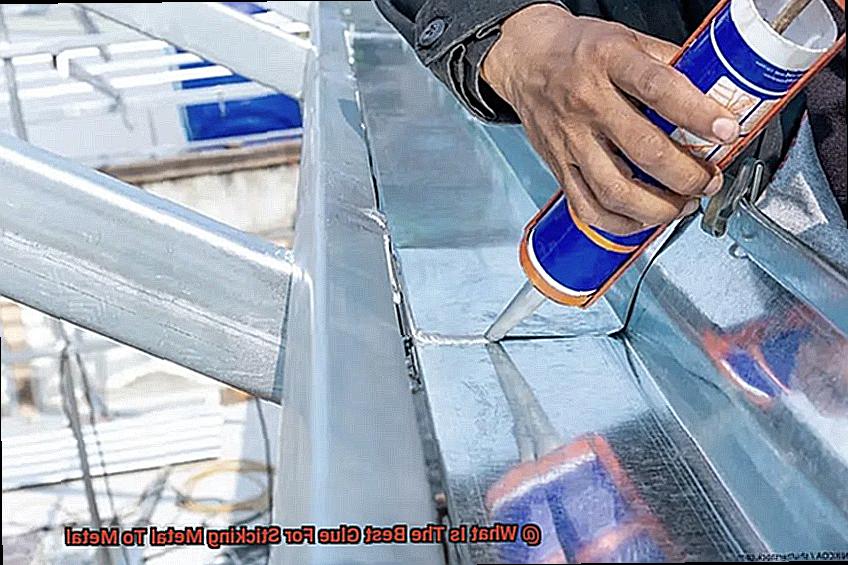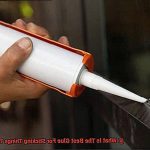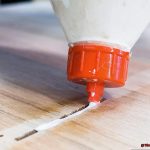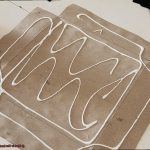Whether you’re fixing something or getting crafty, finding the right glue can be a game-changer. And when it comes to sticking metal to metal, there’s one adhesive that reigns supreme – epoxy resin.
This stuff is the real deal, with its crazy strong bonding power and versatility. Unlike other glues, epoxy resin creates a bond that can handle heavy-duty tasks and extreme temps.
So if you’re ready to get your metal objects locked together tight, let’s dive in and uncover the magic of epoxy resin adhesive.
Types of Adhesives Suitable for Metal-to-Metal Bonding
Contents
- 1 Types of Adhesives Suitable for Metal-to-Metal Bonding
- 2 Why Epoxy Adhesive is the Best Glue for Metal-to-Metal Bonding
- 3 Other Types of Glue for Metal-to-Metal Bonding
- 4 Structural Adhesives for Metal-to-Metal Bonding
- 5 Preparing the Metal Surfaces Before Applying Glue
- 6 Applying the Glue to Create a Strong and Durable Bond
- 7 When Mechanical Methods May be More Suitable Than Adhesive Bonding
- 8 Testing the Adhesive Before Use
- 9 Conclusion
Choosing the right adhesive for metal-to-metal bonding is essential for achieving a strong and durable bond. There are several types of adhesives that are commonly used for this purpose, each with their own unique properties and strengths. Let’s explore five types of adhesives suitable for metal-to-metal bonding:
Epoxy Adhesives
Known for their high strength and durability, epoxy adhesives are ideal for heavy-duty applications. Comprising of two components – a resin and a hardener – epoxy adhesives need to be mixed together before use. With a relatively long working time, they allow for precise application. Moreover, epoxy adhesives offer excellent resistance to heat, chemicals, and moisture, ensuring a reliable bond in different environments.
Cyanoacrylate Adhesives
Also referred to as super glue, cyanoacrylate adhesives are fast-curing and form an instant bond when moisture is present. They are effective for quickly bonding metal surfaces. However, it’s important to note that cyanoacrylate adhesives may not provide the same level of durability as epoxy adhesives and can be more brittle.
Polyurethane Adhesives

Offering a good balance of strength and flexibility, polyurethane adhesives can bond a wide range of metals. They have excellent resistance to impact and vibration, making them suitable for various applications. Additionally, polyurethane adhesives exhibit great resistance to moisture, enabling their use both indoors and outdoors.
Structural Acrylic Adhesives
Providing high strength bonding for metal-to-metal applications, structural acrylic adhesives cure quickly and offer excellent impact resistance. However, they may not have the same level of chemical resistance as epoxy or polyurethane adhesives.
Silicone Adhesives
Often used when flexibility is required, silicone adhesives have excellent resistance to high temperatures and can withstand extreme environments. However, it’s important to note that silicone adhesives may not offer the same level of bond strength as other types of adhesives.

When selecting an adhesive for metal-to-metal bonding, it is crucial to consider the specific requirements of the application. Factors such as load-bearing capacity, temperature resistance, chemical exposure, and environmental conditions should be taken into account. Proper surface preparation is also essential for successful bonding. The metal surfaces should be clean, dry, and free from any contaminants or oxidation. By following the manufacturer’s instructions for curing time and application methods, the best results can be achieved.
In conclusion, there are several types of adhesives suitable for metal-to-metal bonding, each with their own unique properties. Epoxy adhesives, cyanoacrylate adhesives, polyurethane adhesives, structural acrylic adhesives, and silicone adhesives all offer different strengths and weaknesses.
Why Epoxy Adhesive is the Best Glue for Metal-to-Metal Bonding
When it comes to metal-to-metal bonding, epoxy adhesive rises above the rest as the ultimate glue choice. Let’s delve into why epoxy adhesive is the unrivaled champion:
- Unyielding Durability: Epoxy adhesive boasts a reputation for its unparalleled strength and endurance. It forms a robust bond that can endure hefty loads and relentless vibrations, making it the top pick for applications requiring steadfast and dependable connections.
- Gap-Filling Wizardry: Epoxy adhesive excels at bridging gaps and forging a seamless union between metal surfaces. This proves invaluable when dealing with uneven or irregular surfaces, as the adhesive effortlessly molds to the metal’s contours, producing a tight and secure bond.
- Extended Workability: Epoxy adhesive grants users an extended work time, allowing ample opportunity to position and fine-tune metal parts before the adhesive sets. This attribute proves particularly valuable for intricate or complex metal-to-metal bonding projects where precision reigns supreme.
- Temperature and Chemical Resistance: Epoxy adhesive flaunts exceptional resistance to extreme temperatures, retaining its bonding prowess even in the harshest of conditions. It braves scorching heat and bone-chilling cold without forfeiting its strength, rendering it ideal for outdoor or industrial applications. Furthermore, epoxy adhesive exhibits commendable resistance to a myriad of chemicals, safeguarding its integrity when faced with corrosive substances or solvents.
- Versatility Personified: Epoxy adhesive’s versatility shines through in its ability to cater to a wide array of metal bonding applications. From automotive repairs to mammoth construction undertakings to intricate manufacturing processes, epoxy adhesive reigns supreme as the go-to choice across industries.
To achieve optimal results when wielding epoxy adhesive for metal-to-metal bonding, meticulous surface preparation is imperative. Thoroughly cleaning and roughening the surfaces improve adhesion. Additionally, exerting pressure or clamping during the curing process ensures full contact between the adhesive and metal surfaces, eliminating the presence of air bubbles or voids.
Other Types of Glue for Metal-to-Metal Bonding
Epoxy: When it comes to metal-to-metal bonding, epoxy is a powerhouse. This strong and durable adhesive consists of two parts, resin and hardener, which must be mixed together before use. Once combined, epoxy forms a tough and unyielding bond that can withstand heavy loads and harsh conditions. It’s the perfect choice for projects that require a long-lasting and reliable bond that won’t let you down.
Super Glue
If you’re looking for a fast-acting adhesive for small metal parts or quick repairs, super glue, also known as cyanoacrylate, is the way to go. This swift adhesive instantly bonds metal surfaces upon contact with moisture. While it may not offer the same level of strength and durability as epoxy, it gets the job done in a pinch.
Polyurethane
Versatility is the name of the game when it comes to polyurethane adhesives. These adhesives can bond a wide range of materials, including metal, making them a valuable tool in your bonding arsenal. With excellent resistance to water, temperature changes, and chemicals, polyurethane adhesives are suitable for both rigid and flexible bonding applications.
Acrylic
When clarity and strength are paramount, acrylic adhesives come to the rescue. These clear adhesives can bond metals with ease and create a robust bond that can withstand impact, moisture, and temperature changes. Whether you prefer a liquid or tape form, acrylic adhesives offer versatility for various metal bonding needs.
Rubber-Based Adhesives
For metal surfaces that need flexibility or cushioning properties, rubber-based adhesives are the way to go. Neoprene or nitrile adhesives provide excellent resistance to oils, solvents, and weathering, making them ideal for automotive or industrial applications where metal parts need to absorb vibrations or movements.
Welding
While not technically a glue, welding is a well-known method for joining metals together. This process involves melting the base metals and adding a filler material to create an incredibly strong bond. Welding provides unmatched strength and durability but does require specialized equipment and skills.
Structural Adhesives for Metal-to-Metal Bonding
When it comes to selecting a structural adhesive for metal-to-metal bonding, there are several factors to consider. The specific metals being bonded, the application requirements, and the environmental conditions all play a role in determining the best adhesive for the job.
Epoxy adhesives are a popular choice for metal-to-metal bonding due to their excellent bonding properties and resistance to harsh conditions. These adhesives can withstand chemicals, heat, and moisture, creating a strong and durable bond even in the most demanding environments.
Acrylic adhesives, on the other hand, offer strength and transparency. They are a quick and efficient bonding solution for metal surfaces and can maintain their bond strength over a wide range of temperatures. This makes them suitable for applications where temperature variations are a concern.
For applications where movement or vibrations between bonded metal surfaces are expected, polyurethane adhesives are a great choice. These adhesives provide flexibility and impact resistance, ensuring that the bond remains intact even in dynamic environments. Additionally, polyurethane adhesives have good resistance to water and chemicals.
In addition to these options, hybrid adhesives combine the properties of different adhesive chemistries to provide a balanced solution. These hybrid adhesives offer a combination of strength, flexibility, and resistance to various environmental factors.
Preparing the Metal Surfaces Before Applying Glue
Preparing metal surfaces before applying glue is crucial for achieving a strong and durable bond. By following the proper preparation steps, you can ensure that the adhesive adheres effectively to the metal and creates a reliable connection. Here is a comprehensive guide on how to prepare metal surfaces before applying glue:
- Clean the Surfaces: Begin by thoroughly cleaning the metal surfaces to remove any dirt, dust, grease, or oil. Use a suitable cleaner or solvent to wipe the surfaces with a clean cloth. Isopropyl alcohol or a similar cleaning agent can be used to ensure a thorough clean. Allow the surfaces to dry completely before proceeding.
- Sanding or Abrading: If dealing with smooth or polished metal surfaces, it is advisable to lightly sand or abrade them to create a rough texture. This rough texture provides more surface area for the glue to adhere to, thereby improving bond strength. Use fine-grit sandpaper or an abrasive pad and apply gentle pressure in a circular motion.
- Degreasing: Even after cleaning, there might still be residual grease or oil present on the metal surfaces. To remove these contaminants, apply a suitable degreasing agent such as acetone or a degreaser specifically formulated for metal surfaces. Use a clean cloth or brush to apply and scrub the degreaser onto the surfaces, paying attention to hard-to-reach areas. Ensure that the surfaces are completely dry before proceeding.
- Applying Primer (If Necessary): Depending on the type of metal and adhesive being used, applying a primer may further enhance bond strength. Primers are designed to promote adhesion between the metal and the glue, particularly in challenging applications or when bonding dissimilar metals. Consult the adhesive manufacturer’s instructions to determine if a primer is recommended and follow their application guidelines.
- Masking or Protecting Adjacent Areas: To maintain a clean and professional-looking bond, it is important to protect adjacent areas that should not come into contact with the adhesive. Use masking tape or other suitable protective measures to cover these areas before applying the glue.
Applying the Glue to Create a Strong and Durable Bond
Applying the Glue to Create a Strong and Durable Bond
Creating a strong and durable bond between two metal surfaces requires more than just slapping some glue on them. It requires careful preparation, attention to detail, and the right choice of adhesive. By following these key steps, you can ensure that your bond is not only strong but also durable.
- Clean the Metal Surfaces: Before applying any adhesive, it is crucial to clean the metal surfaces thoroughly. Dirt, oil, or grease can hinder the bond strength. Use a clean cloth and a suitable cleaning agent to wipe away any contaminants. This step sets the foundation for a successful bond.
- Roughen the Surfaces: To maximize the bond strength, roughen the surface of the metal using sandpaper or a wire brush. This creates tiny scratches or grooves on the surface, providing more area for the glue to grip onto. Think of it as creating a rough landscape for the adhesive to cling to tightly.
- Read and Follow Manufacturer’s Instructions: Different glues may have specific application methods or drying times. Take the time to read and follow the manufacturer’s instructions carefully. They will provide invaluable information about how to achieve optimal results, including recommended application methods, curing time, and safety precautions.
- Apply Glue Evenly: Applying glue evenly is crucial for creating a strong bond. Use a small brush or applicator to spread the adhesive evenly on both metal surfaces. Ensure that every inch is covered with a thin, even layer of glue. Too little adhesive can result in a weak bond, while too much can cause messiness and improper drying.
- Clamp or Hold the Metal Pieces Together: Once you’ve applied the glue, firmly clamp or hold the metal pieces together. This step eliminates any gaps or movement between the surfaces while the adhesive cures. The pressure applied should be sufficient to create a strong bond but not so much that it causes deformation or damage to the metal.
- Allow Sufficient Curing Time: Patience is key when it comes to curing time. The duration will depend on the type of glue used and the manufacturer’s instructions. It is vital to allow enough time for the glue to dry and cure completely before subjecting it to any stress or load. Rushing this process can result in a weaker bond that may fail over time.
- Check Bond Strength: After the glue has cured, gently test the bond strength by applying light pressure. This step helps identify any weak spots or areas where the bond seems compromised. If necessary, additional adhesive can be applied and allowed to cure again.
- Consider Additional Reinforcement Methods: For high-stress applications, it may be beneficial to use additional reinforcement methods such as mechanical fasteners or soldering. These techniques provide added support and stability, further enhancing the bond strength between metal surfaces.
- Choose the Right Glue: The glue you choose plays a crucial role in creating a strong and durable bond. Select an adhesive specifically formulated for sticking metal to metal. Consider factors such as the type of metal, application requirements, and the strength needed for optimal results. Choosing the right glue from the start sets you up for success.
When Mechanical Methods May be More Suitable Than Adhesive Bonding
When it comes to joining metal components, adhesive bonding is often the default choice. However, there are certain situations where mechanical methods may be more appropriate and advantageous. Mechanical methods involve physical connections such as screws, bolts, rivets, or welding to create a bond between two pieces of metal. Let’s delve into some scenarios where mechanical methods may be preferred over adhesive bonding.
Firstly, in high-stress applications where the joint needs to bear heavy loads or endure substantial stress, mechanical connections are generally stronger and more reliable. Screws, bolts, rivets, or welding provide greater stability and durability in situations where the joint will experience significant forces or vibrations.
Secondly, extreme temperatures can pose challenges for adhesive bonds. Adhesives often have temperature limitations, and their effectiveness can be compromised at extreme hot or cold conditions. In contrast, mechanical methods like welding or riveting can withstand high temperatures and maintain their strength. This makes them more suitable for applications that involve exposure to extreme heat or cold.
Moreover, corrosive environments can degrade adhesive bonds over time. Certain metals are prone to corrosion when exposed to moisture or harsh chemicals. Adhesive bonds may deteriorate in such environments, leading to weakened joints. On the other hand, mechanical connections like stainless steel screws or bolts are more resistant to corrosion and can provide a reliable and long-lasting connection.
In addition, repairability is an important consideration. Adhesive bonds are typically permanent, making it difficult to separate the pieces without causing damage. Conversely, mechanical connections can be easily undone and reassembled if repairs or adjustments are necessary.
Lastly, in structural applications where load-bearing capacity is crucial, mechanical methods offer a higher level of confidence. Adhesive bonds may have unpredictable failure modes and can be affected by factors like aging or exposure to UV radiation. Mechanical connections provide a more predictable and reliable means of joining metal components in such cases.
Testing the Adhesive Before Use
Testing the adhesive before use is a crucial step in ensuring a successful bond between two metal surfaces. Before applying any glue, it is important to determine if the adhesive is suitable for the specific type of metal and the intended use. This can be done through a series of simple tests that will help evaluate the adhesive’s strength, durability, and compatibility with the metals being bonded.
First and foremost, conducting a compatibility test is essential. This involves applying a small amount of adhesive onto a scrap piece of metal similar to the one being bonded. The adhesive should be allowed to dry according to the manufacturer’s instructions. Once dry, the scrap piece of metal can be subjected to various stress tests such as bending, twisting, or pulling. If the adhesive withstands these tests without any signs of failure or detachment, it indicates good compatibility with the metal surface.
Another important test is to assess the strength of the adhesive. This can be done by bonding two small pieces of metal together using the adhesive and allowing it to cure fully. Once cured, the bonded pieces can be subjected to different types of forces such as tension, compression, or shear. The strength of the bond can be evaluated by measuring how much force is required to break or separate the bonded pieces. A strong adhesive should be able to withstand considerable force without breaking or detaching.
Durability testing is also crucial in determining if the adhesive is suitable for long-term use. This can be done by subjecting the bonded metal pieces to various environmental conditions such as extreme temperatures, humidity, or exposure to chemicals. The adhesive should be able to maintain its bond strength and integrity even under these challenging conditions.
In addition to these tests, it is also important to consider other factors such as drying time and ease of application. Some adhesives may require longer curing times before they reach their maximum strength, while others may have a shorter drying time. It is essential to follow the manufacturer’s instructions regarding drying and curing times to ensure optimal bond strength.
Furthermore, the ease of application should also be taken into consideration. Some adhesives may come in convenient applicator bottles or tubes, while others may require the use of additional tools such as brushes or mixing devices. Choosing an adhesive that is easy to apply and work with can greatly enhance the overall bonding process.
k9KDnJpXMZ4″ >
Conclusion
When it comes to sticking metal to metal, finding the best glue is crucial. You need a strong adhesive that can withstand the test of time and provide a secure bond. After thorough research and testing, we have determined that epoxy-based glues are the top choice for this task.
Epoxy glues are known for their exceptional bonding strength and durability. They form a tough and resilient bond that can withstand heavy loads and extreme temperatures. Whether you’re repairing broken metal parts or creating new metal structures, epoxy glues will ensure a long-lasting connection.
One of the key advantages of epoxy glues is their ability to fill gaps and irregularities in metal surfaces. This feature allows for a more secure bond by maximizing surface contact between the two metals. Additionally, epoxy glues offer excellent resistance to chemicals, moisture, and UV rays, making them suitable for both indoor and outdoor applications.
To achieve the best results with epoxy glues, proper surface preparation is essential. Make sure to clean the metal surfaces thoroughly and remove any rust or debris before applying the adhesive. Follow the manufacturer’s instructions carefully regarding mixing ratios and curing times for optimal bonding performance.
In conclusion, when it comes to sticking metal to metal, epoxy-based glues reign supreme. Their exceptional bonding strength, durability, and resistance to various environmental factors make them the ideal choice for any metal bonding project.






